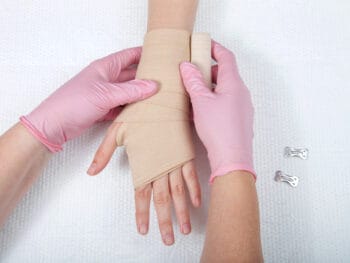
A Case Study: The Anatomy of Repetitive Use Injuries
Frank Smith is a dedicated employee and has been working at the Acme Widget Company for over 20 years. He has never missed a day of work since starting. During a typical 8-hour shift, he will twist some knobs, pull some levers and walks back and forth along the widget-making machine. The day after working a longer than normal shift due to high demand for widgets, Frank wakes up and is experiencing numbness and tingling in his arms. He is later diagnosed with bilateral carpal tunnel syndrome with rotator cuff impingement in his shoulders. Are these conditions work-related?
Click Link to Access Free PDF Download
“13 Research Studies to Prove Value of Return-to-Work Program & Gain Stakeholder Buy-In”
Common Features of Repetitive Use Injuries
The legal definition in every jurisdiction varies on compensability for these injuries. Courts will look at a variety of factors when determining if such conditions are compensable. There are some common aspects across all states workers’ compensation laws:
- Whether the employee is performing “repetitive activity;”
- Whether the repetitive motions or activities place stress on certain joints or body parts; and
- The employee’s work activity must be unusual, in that it brings about a disability that would not occur in normal activities or in another employment.
Best Practices for Claims Investigation
Investigating claims of this nature are difficult given the tricky questions of causation medical experts must answer. This is especially difficult when a workers’ compensation claimant leads an active lifestyle outside of their work environment. Such activities as playing musical instruments, gardening, work with tools, equipment, and other activities of daily living place stress on one’s joints and body.
- Define the specific nature of the employee’s work duties and activities. The use of video demonstrations of work activities and workstations can assist medical and vocation experts render credible opinions regarding causation.
- Investigation into the employee’s prior medical, vocational and work history history. This would include obtain a complete history as to bodily movements they performed in the past and associated medical care for any injuries/conditions. It is also important to find out why people left past positions, and obtain employment records to verify their recollection.
- Determine all the facts surrounding the alleged work condition(s). This should include:
- The development of symptomology and what work activities gave rise to the alleged symptoms;
- The employee’s awareness of their condition(s) and at what points they thought they might have a work-related condition;
- Dates or time periods the employee took time off from work due to their condition(s) and their rationale for taking the time off; and
- The circumstances surrounding and reports of injury the employee made, why they reported the injury and to whom it was reported.
The concept of legal “notice” often comes into play regarding these claimed injuries. It is important to under the case law and relevant legal definitions when defending a repetitive use injury claim.
FREE DOWNLOAD: “13 Research Studies to Prove Value of Return-to-Work Program & Gain Stakeholder Buy-In”
Other Important Considerations
Properly defending repetitive use injuries will also include an independent medical examination. Prior to having the employee seen by a medical expert, it is paramount that as much relevant information is collected beforehand. It is also important to have an expert who has treated the conditions being alleged in the past. If the employee is contemplating surgery, it will also be important to determine your doctor’s surgical experience and expertise.
The question of workplace ergonomics can also come into play. It is important to have this angle of the claim examined, as sometimes a condition cannot occur from a physiological standpoint. Specialists and vocational experts can examine and comment on these issues.

Contact: mstack@reduceyourworkerscomp.com.
Workers’ Comp Roundup Blog: http://blog.reduceyourworkerscomp.com/
©2022 Amaxx LLC. All rights reserved under International Copyright Law.
Do not use this information without independent verification. All state laws vary. You should consult with your insurance broker, attorney, or qualified professional.
















